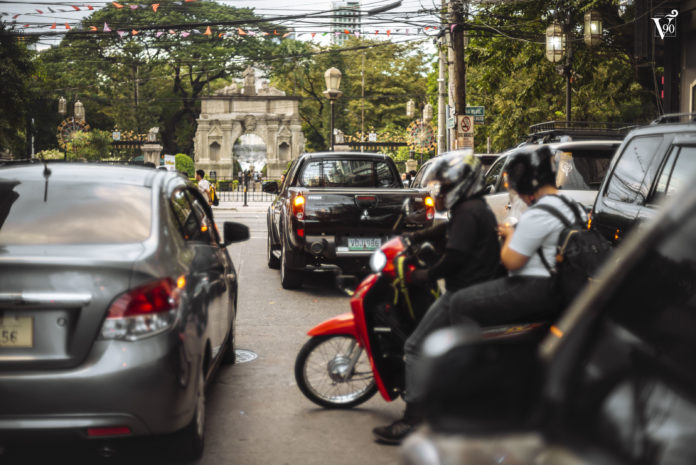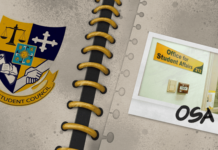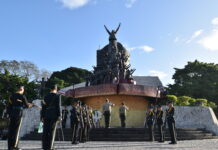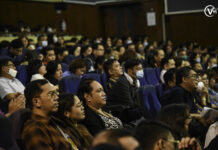
TRAFFIC jams continue to hound Metro Manila despite strict policies in place due to the booming automotive industry in the Philippines and poor enforcement of traffic laws.
Global firm Boston Consulting Group found in a 2017 survey that Metro Manila has the third worst traffic situation in Southeast Asia.
Aside from spending 66 minutes on the road due to traffic jams, drivers also consume an average of 24 minutes daily to search for a parking space. The results also revealed that 84 percent of Metro Manila residents plan to purchase a car in the next five years.
Automotive sales contributed to the country’s gross domestic product (GDP) growth rates that reached 6.8 percent in 2012 and 7.2 percent in 2013, the highest GDP growth rates in Asia. In 2014, the Philippines’s GDP growth rate reached 6.1 percent.
Manila Traffic and Parking Bureau chief Benjamin Feliciano said improving the situation requires disciplined enforcers as he admitted that the enforcement of traffic laws in Manila has not been effective.
He added that Manila City Mayor Joseph Estrada’s order was to remove vendors occupying the roads. Despite this, vendors and cars remain on the sidewalks, as is the case near the Quiapo Church.
“Syempre kung may illegal vendors diyan, `yung tao doon sa kalsada dadaan. Lahat `yan [ay] obstruction. Kasi kung walang obstruction, walang traffic. Illegal parking, lahat `yan obstruction sa kalsada,” Feliciano told the Varsitarian in an interview.
He added that unregulated car ownership causes heavy traffic in the city as the narrow roads cannot accommodate the overwhelming number of cars.
“Ilang libong sasakyan `yung binibili ng tao… Hindi naman puwedeng pigilan ng gobyerno iyan, economical e. Ibig sabihin lumalaki na ang ating economy, `yung traffic hindi na natin natutuunan ng pansin,” he said.
Ruth Equipaje, chairwoman of non-government organization International Network for Traditional Building Architecture and Urbanism, said the volume of cars in Manila alone could be caused by several car owners in a single family. The Manila streets, she added, were historically not made for many vehicles.
“If you backtrack… During that time of smaller cars, we had the kalesa, ‘di ba? And so we have not preempted this, I can say that our streets were not planned to be holding this magnitude of vehicles and people,” she said.
Outdated urban plan
Equipaje said the “outdated” urban plan of Manila should be updated as it contributes to the city’s traffic woes.
“It lacks updating, if I’m not mistaken it was in the 1980s, 1990s pa talaga. And the new plans, we do not really have a comprehensive approach of plans,” she said.
Because Manila is a complex city, officials from neighboring cities should meet to be able to update the city’s urban plan.
The government should also address the problem of sidewalk selling, illegal parking and undisciplined drivers.
“The change is not just adopting a plan but changing how we want to address this traffic situation. We’re not taking it seriously, `yun `yung problem,” she said.
She added that the lack of “walkable” paths in Manila compels people to use private vehicles instead of walking, which further clogs the city’s already congested roads.
Feliciano said there should be “disciplined” traffic enforcers who would implement the laws consistently.
“Kailangan meron kang disiplinadong [empleyado] kasi ang sitwasiyon nagbabago, `di ba? Kaya [nagiging] situational din ang traffic,” Feliciano said.
Traffic officials, for instance, should always be rotated to prevent corruption.
‘Ineffective’ mass transport systems
Engineer Albert Surla, assistant director at the UST Facilities and Management Office, said the government should exert more effort in improving the country’s mass transport system to solve the traffic congestion in Manila.
“[Some] countries have an effective public transportation. Well… [madi-discourage] ka dito, if you take the public transport, ang worry mo ay safety mo,” he said.
Equipaje said if the public would have a pleasant commuting experience, decongestion of the roads would follow suit.
“It’s the role of the government to provide other options of commuting that are comfortable,” she said.
The government is also opening its doors to installing cable cars in the metropolis as the Department of Transportation launched a P27 million-study last Nov. 14 on the feasibility of cable cars in Metro Manila.
Transport Secretary Arthur Tugade said there was no single answer to the heavy Metro Manila traffic, but installing cable cars could be among the “basket of solutions.”
“Admittedly, not one system can solve the situation of transportation and traffic in the Philippines. Not a cable system alone can solve the problems; it has got to be a basket of solutions, procedures and systems. And one of those baskets is certainly cable,” he said.


















